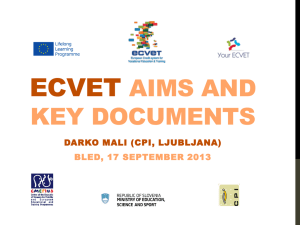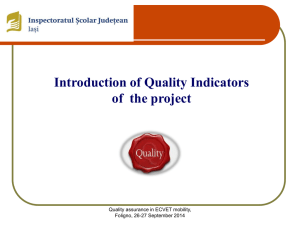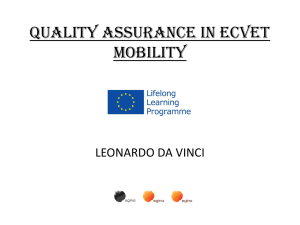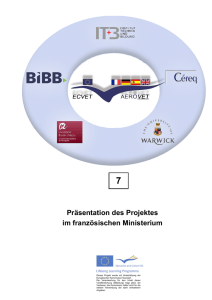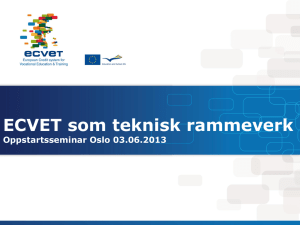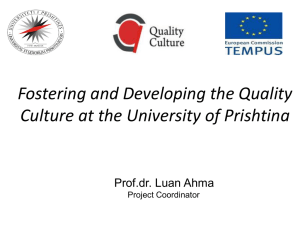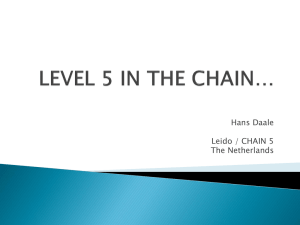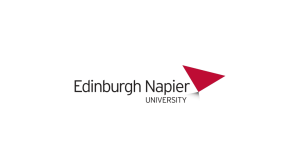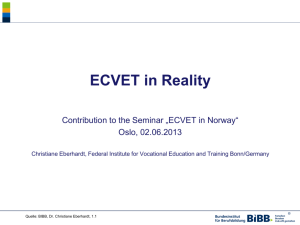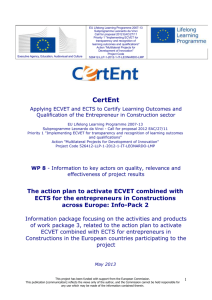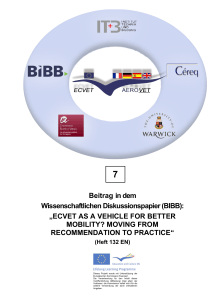«QUALITY ASSURANCE IN ECVET MOBILITY»
advertisement
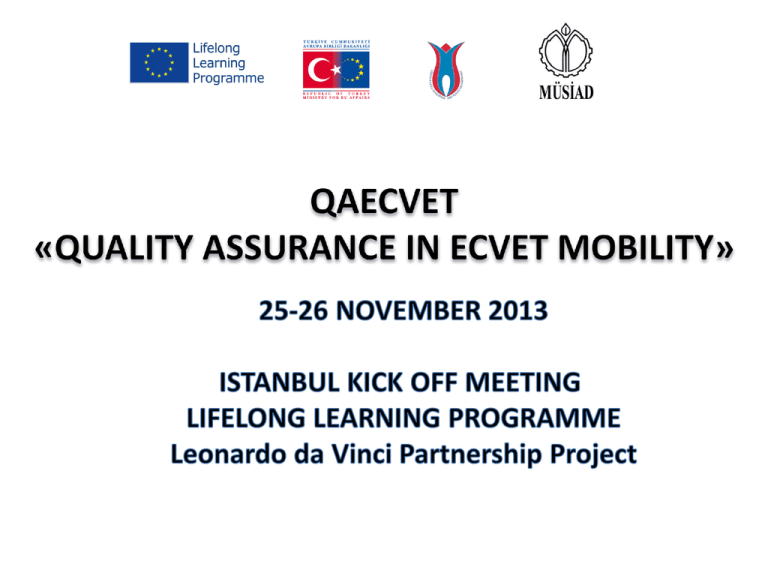
• In Europe, When you ask the VET stakeholders : What does Quality Assurance mean for VET system? • You can get the following answer: • Quality is not an absolute value but the result of a negotiation between different actors aiming at providing trainees with knowledge, skills and competences needed in the society. • Since 2010 EQAVET (European Quality Assurance Reference Framework for Vocational Education and Training) has identified cooperation with ECVET (European Credit System in Vocational Education and Training) and EQF (European Qualifications Framework) as an important priority in ensuring the sustainability of the EU tools. • When thinking about the use of ECVET to support the geographical mobility of learners in a partnership framework. If we look at each of the four stages of the EQAVET quality circle, there are many activities within a mobility programme that contribute to quality assurance. • ECVET Promoters often use ECVET’s technical specifications which include elements of quality assurance e.g. the Memorandum of Understanding and the Learning Agreement. • ECVET promoters see the ECVET technical specifications as containing elements of quality assurance. Although they do not use the vocabulary of quality assurance or use the four stages of the European Quality Assurance in Vocational Education and Training (EQAVET) cycle, they put in place quality assurance processes. • Sometimes it is not always easy to distinguish between what the technical specifications require and what is quality assurance. Tools such as a Memorandum of Understanding or a Learning Agreement are elements to ECVET implementation and they are also key instruments for quality assurance. • The Recommendation on the establishment of a European Quality Assurance Reference Framework for VET, includes a set of selected quality indicators for assessing quality in VET. • These cover the characteristics of VET systems and include measures such as employment rates and investment in training of teachers and trainers. • Many of the examples showed that using assessment criteria in the implementation phase requires a previous planning phase involving the relevant stakeholders in a rigorous training design of learning outcomes. • The last is the review phase that has been established as a crucial component for improvement in practice. • The discussions while using the quality cycle and taking into consideration the overall actors involved, revealed the importance of going through the 4 phases of the EQAVET quality assurance circle (planning, implementation, evaluation, review). When planning mobility on ECVET, the following issues should be realized: • identify the learning outcomes that the learners were expected to achieve abroad; • discuss learning outcomes with a partner institution to ensure there is a common understanding between the partners (all projects had discussions about the definition of learning outcomes with their partners); • describe learning outcomes in a Learning Agreement which is signed by the learner who becomes aware of the expectations placed on them (all those projects that tested ECVET through real mobility did this); • clarify how unit(s) based on learning outcomes would be validated and recognised and under what conditions; • put measures in place to ensure that when the learner returns their unit(s) would be validated and if possible (depending on national rules) recognised When implementing the mobility on ECVET, the organizers should: • ensure that the learning activities are ongoing and that learners took part in activities which related to the agreed learning outcomes; • ensure that the assessment is carried out abroad; • on the learners’ return, received documentation about each learner’s assessment (transcript of record). These were then reviewed and the organisers verified that the conditions that enabled them to validate credit had been met. On the learners’ return, the organisers should: • gather information of whether each learner’s credit had been validated and recognised; • identify, if this had not happened, the reasons why; • collect feedback from learners, teachers and partner organisations on what had worked and what had not worked in relation to the instruments and methods they had developed • Many studies and projects were designed to test ECVET. In all these studies, the review phase was used to reflect on their experiences and to provide conclusions and recommendations for the future use of ECVET. • When ECVET is implemented, the review phase should be used to improve future mobility exchanges. In addition to aspects of quality assurance that can be organised in relation to the EQAVET quality cycle, it is possible to think of quality assurance from the perspective of ‘ECVET functions’. • For each function the outcomes need to be quality assured e.g. most projects made sure that descriptions of learning outcomes covered the knowledge, skills and competences that are relevant for the professions involved in the mobility project. • They involved experts in the process (such as the chamber of commerce) or included a validation stage where experts reviewed the descriptions of learning outcomes. • To ensure the host organisation provided appropriate learning opportunities and could deliver the unit to the required quality. • Teachers in the host institution then made sure that the local host enterprise was able to prepare the student to meet the expected learning outcomes. • To ensure assessment in the host organisation was comparable to assessment by the home institution, some projects developed common assessment grids to record students’ results, descriptions of a unit’s learning outcomes were accompanied by a description of the assessment criteria and indicators which supported the assessment process. • The way projects consider quality assurance is still a ‘work in progress’. • However we know that the expectations and requirements for quality assurance are likely to differ depending on whether conversations are with a certification body or a training centre. • The requirements also differ when credit transfer relates to organised mobility of students compared to another form of mobility. Some quality assurance measures are likely to appear too onerous for a short term mobility project. • In conclusion, based on the work from the pilot projects and studies on ECVET, it is clear that there isn’t a common understanding of what is important for quality assurance when using ECVET. More work will be needed to develop this common understanding. • In this context, it is worthwhile noting that the ECVET’s Guide on Mobility, would identify quality assurance issues that support geographical mobility. This should start the process of building a common understanding.
